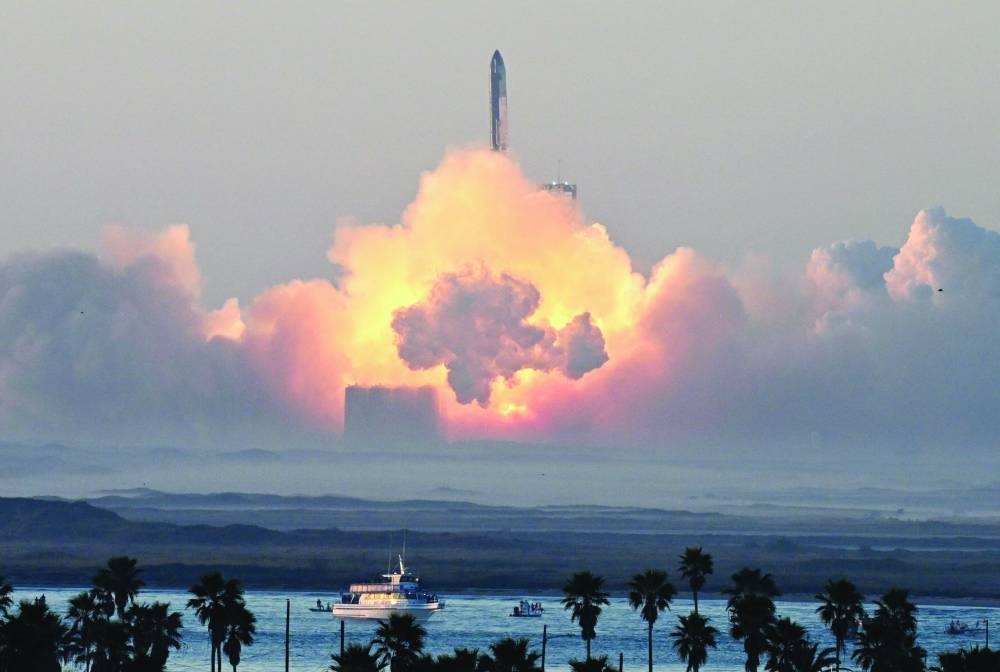SpaceX’s uncrewed spacecraft Starship, developed to carry astronauts to the moon and beyond, failed in space shortly after lifting off yesterday, cutting short its second test but making it further than an earlier attempt that ended in an explosion.
The two-stage rocketship blasted off from the Elon Musk-owned company’s Starbase launch site near Boca Chica in Texas, helping boost the Starship spacecraft as high as 90 miles above ground on a planned 90-minute test mission to space and back.
But the rocket’s Super Heavy first stage booster, though it achieved a crucial manoeuvre to separate with its core Starship stage, exploded over the Gulf of Mexico shortly after detaching, a SpaceX webcast showed.
Meanwhile, the core Starship stage boosted further toward space, but a few minutes later a company broadcaster said that SpaceX mission control suddenly lost contact with the vehicle.
“We have lost the data from the second stage...we think we may have lost the second stage,” SpaceX engineer and livestream host John Insprucker said. He added that engineers believe an automated flight termination command was triggered to destroy the rocket, though the reason was unclear.
About eight minutes into the test mission, a camera view tracking the Starship booster appeared to show an explosion that suggested the vehicle failed at that time. The rocket’s altitude was 91 miles.
The launch was the second attempt to fly Starship mounted atop its towering Super Heavy rocket booster, following an April attempt that ended in explosive failure about four minutes after lift-off.
The US Federal Aviation Administration, which oversees commercial launch sites, confirmed a mishap occurred that “resulted in a loss of the vehicle,” adding no injuries or property damage have been reported.
The agency said it will oversee a SpaceX-led investigation into the testing failure and will need to approve SpaceX’s plan to prevent it from happening again.
The mission’s objective was to get Starship off the ground in Texas and into space just shy of reaching orbit, then plunge through Earth’s atmosphere for a splashdown off Hawaii’s coast. The launch had been scheduled for Friday but was pushed back by a day for a last-minute swap of flight-control hardware.
Starship’s failure to meet all of its test objectives could pose a setback for SpaceX. The FAA will need to review the company’s failure investigation and review its application for a new launch licence. SpaceX officials have complained that such regulatory reviews take too long.
On the other hand, the failure in a program for which SpaceX plans to spend roughly $2bn this year was in line with the company’s risk-tolerant culture that embraces fast-paced testing and re-testing of prototypes to hasten design and engineering improvements.
“More things were successful than in the previous test, including some new capabilities that were significant,” said Carissa Christensen, CEO of space analytics firm BryceTech.
“There’s not money and patience for unlimited tests, but for a vehicle that is so different and so big, two, three, four, five tests is not excessive,” Christensen said.
At roughly 43 miles in altitude, the rocket system executed the crucial manoeuvre to separate the two stages — something it failed to do in the last test — with the Super Heavy booster intended to plunge into Gulf of Mexico waters while the core Starship booster blasts further to space using its own engines.
But the Super Heavy booster blew up moments later, followed by the Starship stage’s own explosion. SpaceX in a post on social media platform X said “success comes from what we learn,” adding that the core Starship stage’s engines “fired for several minutes on its way to space.”
A fully successful test would have marked a key step toward achieving SpaceX’s ambition producing a large, multi-purpose, spacecraft capable of sending people and cargo back to the moon later this decade for Nasa, and ultimately to Mars.

SpaceX's Starship rocket launches from Starbase during its second test flight in Boca Chica, Texas, yesterday. (AFP)
